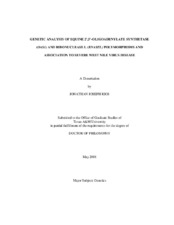| dc.contributor.advisor | Adelson, David L. | |
| dc.contributor.advisor | Spencer, Thomas E. | |
| dc.creator | Rios, Jonathan Joseph | |
| dc.date.accessioned | 2010-01-15T00:07:11Z | |
| dc.date.accessioned | 2010-01-16T00:54:15Z | |
| dc.date.available | 2010-01-15T00:07:11Z | |
| dc.date.available | 2010-01-16T00:54:15Z | |
| dc.date.created | 2008-05 | |
| dc.date.issued | 2009-05-15 | |
| dc.identifier.uri | https://hdl.handle.net/1969.1/ETD-TAMU-2749 | |
| dc.description.abstract | West Nile virus (WNV), a member of the Flaviviridae family of RNA viruses,
was first introduced to the United States in 1999 with rapid transmission across a variety
of hosts throughout the continental states. Genetic research to identify genes involved in
resistance and susceptibility to WNV began in mice, where it was observed that natural
populations were resistant or fatally susceptible. Further investigation led to the
identification of the Flavivirus resistance gene as the oligoadenylate synthetase 1b gene
in mice. A nonsense mutation was found within the coding region of this gene that
associated absolutely with susceptibility to WNV.
A two-stage association study was conducted to identify similar genetic
associations to West Nile encephalitis in naturally susceptible and resistant populations
of horses in the United States.
Genomic sequence of a majority of the equine 2’,5’-oligoadenylate synthetase 1
(OAS1) gene was assembled by shotgun-sequencing CHORI BAC 100:I10 (3.95X). A
contig map spanning the entire gene was constructed, including 8 kilobases of promoter sequence upstream of the first exon. Coding regions of equine OAS1 and ribonuclease L
(RNASEL) genes, as well as the OAS1 promoter, were screened for mutations from a
random sample of horses of multiple breeds. Numerous polymorphisms were identified
for case-control analyses. Analysis using Fisher’s Exact test identified allelic and
genotypic associations. Odds ratios were also determined to measure strength of the
associations. Case-control analysis of haplotype frequencies identified significant
differences in haplotype frequencies between populations and association to West Nile
encephalitis.
A conserved interferon-stimulated response element was mapped to within 518
basepairs upstream of the transcription start site of OAS1. Promoter polymorphisms
were not found to affect induction by interferon-tau; however, additional analyses are
necessary to further characterize the equine OAS1 promoter and the host factors involved
in regulating expression.
Statistical analyses of the genotype data from the case and control populations
identified significant associations between polymorphisms of the OAS1 and RNASEL
genes with severe West Nile encephalitis. The similarity between human and horse OAS
immunity genes suggests that the horse may provide a genetic model to further
investigate mammalian SNP-associated viral susceptibility. | en |
| dc.format.medium | electronic | en |
| dc.format.mimetype | application/pdf | |
| dc.language.iso | en_US | |
| dc.subject | OAS/RNASEL | en |
| dc.subject | WNV | en |
| dc.title | Genetic analysis of equine 2', 5'-oligoadenylate synthetase (OASI) and ribonculclease L (RNASEL) polymorphims and association to severe West Nile Virus disease | en |
| dc.type | Book | en |
| dc.type | Thesis | en |
| thesis.degree.department | Animal Science | en |
| thesis.degree.discipline | Genetics | en |
| thesis.degree.grantor | Texas A&M University | en |
| thesis.degree.name | Doctor of Philosophy | en |
| thesis.degree.level | Doctoral | en |
| dc.contributor.committeeMember | Chowdhary, Bhanu P. | |
| dc.contributor.committeeMember | Huber, Jr., John C. | |
| dc.contributor.committeeMember | Skow, Loren C. | |
| dc.type.genre | Electronic Dissertation | en |
| dc.type.material | text | en |
| dc.format.digitalOrigin | born digital | en |


